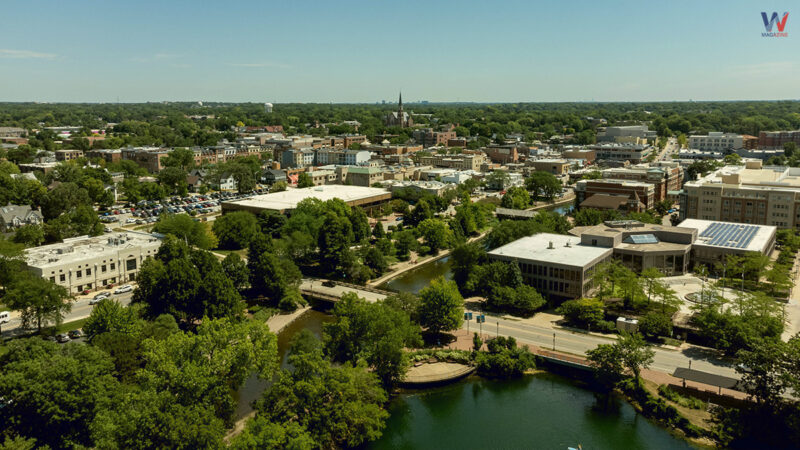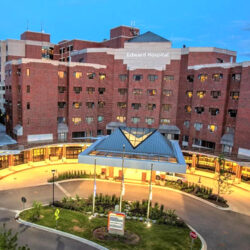Table of Contents
Naperville is a city located in DuPage and Will counties in Illinois, about 28 miles west of Chicago along the DuPage River. As of the 2020 census, it had a population of 149,540, making it the fourth-largest city in the state.
Founded in 1831 by Joseph Naper, Naperville was initially called Naper’s Settlement. By 1832, the settlement had grown to over 100 residents. In 1839, when DuPage County was formed from part of Cook County, Naperville became the county seat, a title it held until 1868. The city saw a big population boost starting in the 1960s due to the expansion of the Chicago metropolitan area.
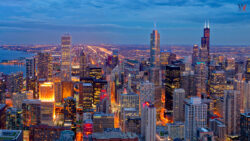
Naperville features Moser Tower and the Millennium Carillon, one of the largest carillons in the world. The city also boasts a wide array of parks and forest preserves including the popular Centennial Beach. Naperville is served by two school districts, 203 and 204. The largest employer in the city is Edward Hospital which has 4,500 employees. Additionally, Naperville has a train station that is serviced by both Amtrak and Metra.
The community is also supported by various local services that make life easier for residents. For instance, when moving to or within Naperville you can rely on the local moving services available to ensure a smooth move into your new home. Stay with Wordle Magazine to learn more about Naperville.
History
The Martin-Mitchell Mansion, located within the Naper Settlement outdoor museum is listed on the National Register of Historic Places.
Before any European settlers arrived the area that is now Naperville was inhabited by Native American tribes. The first European contact with Native Americans in Illinois occurred in 1641 when members of the Iliniwek tribe were encountered. At that time, the Iliniwek tribe was the main group in Illinois. However, they were later pushed out by the Potawatomi tribe.
By the time the first settlers arrived in Naperville, the Potawatomi tribe had established their presence. There was a significant Potawatomi village at what is now downtown Naperville. This village could be reached from Chicago by a path that eventually became Ogden Avenue. Another smaller village was near the location where Bailey Hobson built his mill in 1834.
In 1831, Joseph Naper arrived on the west bank of the DuPage River with his family and friends to establish what would later be called Naper’s Settlement. Among the first settlers were Naper’s wife, his brother and his brother’s wife, his sister and her husband John Murray and his mother. They traveled for nearly two months from Ashtabula County, Ohio, on the Naper brothers’ schooner, the Telegraph.
By 1832, over 100 settlers had arrived in Naper’s Settlement. After hearing about the Indian Creek massacre during the Black Hawk War these settlers temporarily moved to Fort Dearborn for protection against a possible attack by the Sauk tribe. A fort, Fort Payne, was built at Naper’s Settlement and the settlers returned. The anticipated attack never happened.
In 1834, the Pre-Emption House was built, marking the Settlement as a stagecoach stop on the road from Chicago to Galena. This building was the first hotel in DuPage County.
When DuPage County was separated from Cook County in 1839, Naper’s Settlement became the county seat. In 1843, the Illinois General Assembly created the Naperville Cemetery Association.
In 1855, Sybil Dunbar arrived in Naperville as the first recorded black female resident. She lived there until her death in 1868 and was buried in Naperville Cemetery.
In 1857, Naper’s Settlement was officially incorporated as the Village of Naperville, with a population of 2,000. However, in 1868, Naperville lost its status as the county seat to Wheaton.
On August 5, 1873, a train accident occurred about 1.5 miles east of Naperville on the CB&Q tracks. Conductor Williams, operating a passenger train was warned about a freight train on the line but increased his speed anyway. He collided with a freight caboose while rounding a curve. The collision instantly killed a conductor sitting in the caboose and a cattle drover. The fireman and engineer of the passenger train managed to jump out just in time to save their lives.
In 1887, Peter Edward Kroehler founded the Kroehler Manufacturing Company’s factory in Naperville near the Chicago, Burlington & Quincy tracks. Naperville was reincorporated as a city in 1890.
In 1898, Nichols Library was built and dedicated after Professor James Nichols donated $10,000. In January 1907, Edward Sanatorium (now Edward Hospital) opened, founded by Eudora Hull Spalding. The sanatorium used the “open air” treatment for tuberculosis patients.
In 1908, the Chicago YMCA claimed that Naperville was too small for its own YMCA building. However, Peter Kroehler led a campaign to build one. By January 1910, Kroehler, who was then the mayor and the richest resident of Naperville, resigned amid rumors about his relationship with his stenographer. He moved to his factory in Binghamton, New York. Despite these events the YMCA opened on March 26, 1911 and featured the first swimming pool in DuPage County.
In February 1920, Edward Sanatorium was destroyed by fire. It cost $500,000 to rebuild.
On April 26, 1946, Naperville experienced a tragic train accident when two Chicago, Burlington and Quincy Railroad trains collided end-to-end on a single track near the Loomis Street crossing. The collision resulted in 45 deaths and around 127 injuries among passengers and crew members.
During the 1950s, Naperville covered about six square miles. However, in 1960, the city expanded significantly, annexing over 1,500 acres in a single year, marking the largest geographical growth in its history.
In 1955, the Edward Sanatorium was transformed into a general hospital.
Naperville was mainly a rural area for most of its history but its population began to boom in the 1960s and continued to grow rapidly through the 1980s and 1990s. During the ’80s and ’90s, the population tripled.
In 1996, Naperville was hit by a major flood that affected much of northeastern Illinois. The city received 14 inches of rain in less than a day, leading to DuPage County being declared a disaster zone. The flood caused over $30 million in damages.
The YMCA in Downtown Naperville which had been in operation for 109 years announced its closure in May 2020 due to financial struggles from the COVID-19 pandemic.
On June 20, 2021, an EF3 tornado struck southeast Naperville, causing significant damage. The tornado uprooted trees, injured eight people and damaged 231 homes.
Geography
Based on the 2021 census, Naperville spans 39.68 square miles (102.77 km²). Of this, 39.10 square miles (101.27 km²) is land, making up 98.52% and 0.59 square miles (1.53 km²) is water, accounting for 1.48%.
Some parts of Naperville drain into the West Branch of the DuPage River in DuPage County. The Forest Preserve District owns a significant amount of land along the West Branch which has limited development in floodplains and helped reduce flood damage in more developed areas. The DuPage River Trail which follows the river is popular with bikers and pedestrians.
Before it was settled, Naperville was mostly flat prairie. Its main geographical features now are manmade hills such as Greene Valley Hill which used to be a garbage dump.
Naperville has experienced two major floods, one in 1996 and another in 2013.
Naperville spans six townships and two counties. In DuPage County, it is divided into four parts: the northwest in Winfield Township, the northeast in Milton Township, the west-central in Naperville Township and the east-central in Lisle Township.
In Will County, Naperville’s southwest part is in Wheatland Township and the southeast part is in DuPage Township. Most residents live in Lisle Township, followed by Naperville Township.
Naperville’s city boundaries have several noticeable cut-ins. In the west Springbrook Prairie a large forest preserve managed by the Forest Preserve District of DuPage County, forms a significant area. In the southwest, the Tamarack neighborhood is a significant unincorporated area. In the north, McDowell Grove Forest Preserve and several office complexes along Diehl Road form a major area within the city’s limits.
Climate
Naperville has a typical Midwestern humid continental climate (Köppen Dfa), with four distinct seasons: cold and snowy winters, humid springs, hot summers and cool falls. The highest recorded temperature is 105°F, and the coldest is -29°F.
Climate Data for Naperville, Illinois

Demographics
Historical Population
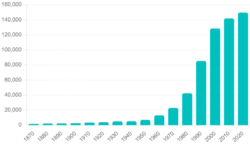
As of the 2020 census, Naperville had a population of 149,540 people, living in 52,648 households and 39,443 families. The population density was 3,768.36 inhabitants per square mile (1,454.97/km²). There were 55,348 housing units, with an average density of 1,394.75 per square mile (538.52/km²).
Racial Makeup
- 39% White
- 99% African American
- 17% Native American
- 29% Asian
- 03% Pacific Islander
- 23% Other races
- 89% Two or more races
- 94% Hispanic or Latino of any race
Household Composition
- 3% had children under 18
- 65% were married couples living together
- 40% had a female householder with no husband present
- 08% were non-families
- 35% were individuals living alone
- 33% had someone 65 or older living alone
- Average household size: 3.24
- Average family size: 2.76
Age Distribution & Income
In Naperville, the age distribution is as follows:
- 3% are under 18 years old
- 9% are between 18 and 24 years old
- 25% are between 25 and 44 years old
- 6% are between 45 and 64 years old
- 0% are 65 years or older
The median age in the city is 39.1 years. For every 100 females, there are 96.8 males. Among adults 18 and over, there are 93.7 males for every 100 females.
The median household income in Naperville is $127,648, while the median family income is $150,075. Men have a median income of $94,340 compared to $47,690 for women. The city’s per capita income is $58,075.
Approximately 2.6% of families and 3.8% of the overall population live below the poverty line including 4.3% of those under 18 and 3.2% of those 65 and older.
Naperville City, Illinois – Racial & Ethnic Composition
Note: The US Census treats Hispanic/Latino as an ethnic category, separate from racial categories.
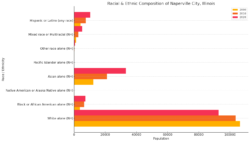
“Naperville is the 181st most populous city in the United States.”
Economy
Naperville is part of the Illinois Technology and Research Corridor. Several major employers contributed to the city’s population growth in the 1980s and 1990s, including:
- Bell Labs and Western Electric (now Nokia)
- Amoco (now BP and Ineos)
- Nalco
- Calamos
- Nicor
- Edward Hospital
ConAgra’s Grocery division branch office in Naperville employs around 400 workers. Kraft Foods, now known as Mondelez International, opened its Naperville site in 1968. This plant, which produces all Triscuit products for North America, employs over 200 people.
Naperville is home to the headquarters of Dukane Precast and its double-wall precast concrete manufacturing plant. During the 1990s, it was one of the nation’s ten fastest-growing communities. The city also hosted the Office Max headquarters until its 2013 merger with Office Depot after which the headquarters moved to Boca Raton and the Naperville site was sold.
According to Wordle Magazine’s research, the Naperville area features many retailers, restaurants, moving companies and shopping centers including Downtown Naperville, Freedom Commons, Springbrook Prairie Pavilion and the Route 59 and Ogden Avenue corridors. There are over 11 automobile dealerships in the city. In October 2006, Naperville opened the country’s first public-private partnership automobile test track, located on a 9-acre course, costing $1.5 million.
Commuting & Employment
According to the 2019 American Community Survey:
- 77% of commuters drove to work.
- 11% used public transportation.
- 6% worked from home.
Regarding employment sectors:
- 1% of workers were in educational services, healthcare and social assistance.
- 4% worked in professional, scientific, management, administrative and waste management services.
- 3% were employed in arts, entertainment, recreation, accommodation and food services.
- 7% worked in retail trade.
- 5% were in finance, insurance, real estate, rental and leasing.
According to the city’s 2020 Comprehensive Annual Financial Report, the top ten employers in Naperville are:

Arts & Culture
Library
The Naperville Public Library operates three branches within the city. In 2020, the library had 61,476 active cardholders, 728,147 total visits and 2,973,939 checkouts.
The library was established thanks to a bequest from James Nichols, a Naperville resident who left $10,000 to the city to create a library. The Nichols Library officially opened on September 22, 1898, with a collection of over 700 books. As Naperville’s population grew, the original library became too small. In 1983, a referendum was passed to build a new library and the new Nichols Library opened on March 11, 1986.
With continued population growth, the library needed more branches. Land was acquired and the Naper Boulevard Library’s upper floor opened on December 29, 1992. To serve South Naperville, the 95th Street Library was opened on September 21, 2003.
The Nichols Library is located in downtown Naperville on Jefferson Street. It opened in March 1986 and is a 63,300 square foot (5,900 m²) building. The old library building is still standing on Washington Street, just south of where the YMCA building was before it was demolished in 2022, at Washington and Van Buren.
The Naper Boulevard Library, opened in December 1992, is situated on Naper Boulevard, south of Scott Elementary School. It underwent internal renovations in 2015. It is the smallest of the three libraries covering 32,000 square feet (3,000 m²).
The 95th Street Library, located near the intersection of 95th Street and Route 59, just west of Neuqua Valley High School, opened in September 2003. It is the newest and largest library, spanning 73,000 square feet (6,800 m²) and features a modern architectural style.
In 2022, the Naperville Public Library was rated the best in the nation within its expenditure range by Library Journal.
Art
Naperville hosts the Naperville Independent Film Festival, an annual event showcasing the work of independent filmmakers.
The Naperville Municipal Band, a nonprofit organization founded in 1859, performs a summer concert series in Central Park and several other concerts around the city. The band is made up of over 90 volunteer musicians.
The Naperville Art League organizes the Riverwalk Fine Art Fair annually. This event, running since 1984, features artists who create works in various mediums including painting, ceramics, wood, jewelry, fiber, photography, glass and metal.
The Century Walk Corporation founded in 1996, is a nonprofit organization that commissions sculptures, murals and mosaics around the city. As of February 2021, they have installed 51 statues and over $4 million worth of art. Notable pieces include a 9-foot-tall statue of the comic book character Dick Tracy, a life-size statue of a 30-year-old Abraham Lincoln called Laughing Lincoln and the Dan Shanower Sept. 11 Memorial which features a steel beam from the World Trade Center and rubble from the Pentagon.
Historical Preservation
The Naperville Historic District includes 573 buildings in the older eastern part of Naperville and is listed on the National Register of Historic Places (NRHP) since September 29, 1977. The Naperville City Council designated it a local district in 1986. These buildings are significant examples of local architecture and are an important part of the city’s cultural and historical heritage.
The Old Nichols Library building, Naperville’s original public library was designated a local landmark in 2017.
Naper Settlement is an outdoor history museum that represents the era of Naperville’s founding. Established in 1969 by the Naperville Heritage Society and the Naperville Park District, it preserves some of the community’s oldest buildings. The museum includes reconstructions of Fort Payne and the Pre-Emption House.
Moser Tower & Millennium Carillon
The 158-foot-tall Moser Tower is located just north of Aurora Avenue at the base of Rotary Hill, west of Downtown Naperville. The Millennium Carillon, housed in the tower, is one of the four largest carillons in the world. It has 72 bronze bells with the smallest weighing 10 pounds and the largest, called the “Captain Joseph Naper Bell” weighing 6 tons. It was dedicated on June 29, 2000, during an Independence Day event attended by over 15,000 people. The carillon can be played manually or by a computer with most performances done by hand while a computer-controlled system plays half of the bells at scheduled times throughout the day.
Other Museums
The DuPage Children’s Museum, founded in 1987, relocated from Wheaton to Naperville in 2001. It was rebuilt and redesigned in 2015.
Parks & Recreation
Naperville Park District
The Naperville Park District offers leisure and recreational activities for residents of Naperville and nearby areas. Established by referendum in 1966, it manages over 2,400 acres (10 km²) of open space including more than 136 parks, two golf courses, 73 playgrounds and over 70 miles of trails. Centennial Beach, a popular park was founded in 1932.
Riverwalk
The Park District is also responsible for the Naperville Riverwalk which was constructed beginning in 1981 to commemorate the 150th anniversary of Joseph Naper’s settlement. The Riverwalk is 1.75 miles (2.82 km) long and runs along the West Branch of the DuPage River, featuring brick paths, fountains, covered bridges, art pieces and nearby restaurants.
The Naperville Riverwalk Commission has proposed the “Riverwalk 2031 Master Plan” aiming to extend the Riverwalk to Edward Hospital, build a new park and create an east bank path from the Highlands subdivision.
Other Facilities
The Naperville Park District manages several other properties:
- Centennial Beach: A former quarry turned into a beach.
- Golf Courses: Springbrook and Naperbrook.
- Skate Parks: Frontier Sports Complex and Centennial Park, dedicated to skateboarding and in-line skating.
- Commissioners Park: Opened in 2006, it includes Naperville’s first official cricket pitch.
- Ron Ory Community Garden Plots: Offers garden plots for lease during the summer for a fee.
- Knoch Knolls Park: Features a small mountain biking trail and an eighteen-hole frisbee golf course, located between Ring Road and 95th Street.
- Naperville Sportsman’s Club: A public trap shooting range charges $15.50 for club members, $16.75 for residents and $18.00 for non-residents.
Forest Preserve District of DuPage County
The Forest Preserve District of DuPage County manages several forest preserves and parks in Naperville:
- Springbrook Prairie: Covers 1,829 acres (740 ha) and includes 13 miles (21 km) of trails.
- Greene Valley Forest Preserve: A former landfill and farm, it spans 1,388 acres (562 ha) with 12 miles (19 km) of trails.
- Herrick Lake Forest Preserve: Encompasses 887 acres (359 ha) and has 7 miles (11 km) of trails.
- McDowell Grove Forest Preserve: Covers 465 acres (188 ha) and includes 7 miles (11 km) of trails.
- Pioneer Park: Home to the Hobson Monument and a grist mill, with a section of the DuPage River Trail for walking, running and cycling. It also offers access to the DuPage River for fishing, canoeing and kayaking.
The Forest Preserve District of Will County manages Whalon Lake Forest Preserve which offers trails and lake access.
Government
Naperville operates under a council-manager form of government. The City Council consists of the Mayor and eight Council Members all elected for four-year terms. No one can serve as Mayor or Council Member for more than three consecutive terms.
The City Council has the authority to:
- Select and appoint a city manager.
- Adopt, amend and repeal ordinances.
- Approve the city’s annual operating budget.
The Mayor, in addition to being a City Council member, has extra responsibilities:
- Presides over city council meetings.
- Acts as the local Liquor and Tobacco Control Commissioner.
- Can declare emergencies.
- Selects members for city boards and commissions.
The City Manager enforces all laws and ordinances, recommends actions to the council and oversees all city departments.
Mayor Scott Wehrli (R) is the current mayor of Naperville, serving since 2023. Former Mayor George Pradel also known as “Officer Friendly” served for 20 years, making him the longest-serving mayor in Naperville’s history.
In 2021, the city approved a $540 million budget for 2022, a 7.6% increase from the previous year. About $32 million of the $38 million budget increase was allocated to infrastructure improvements.
In 2020, the city employed 933 people.
Taxes
In 2020, the equalized assessed value for Naperville was $137,000, with a city property tax rate of 0.6949%. This resulted in an average property tax payment of $875.11. The city also collects a local gas tax of four cents per gallon.
Naperville has several sales taxes:
- A 0.75% tax on general merchandise and food for immediate consumption.
- A 1% tax on all food and beverages consumed at the place of purchase.
- An additional 0.75% tax on food and beverages purchased within Downtown Naperville.
Real estate transfers are taxed at $1.50 per $500 of the purchase price with the price rounded up in $500 increments. However, this tax does not apply to deed changes by owners.
Hotel and motel stays are subject to a 5.50% tax on the room rate.
State-collected income taxes, sales taxes and motor fuel tax proceeds are distributed to municipalities based on population. The total state use tax rate is 6.25% and Illinois collects $0.392 per gallon of gasoline and $0.467 per gallon of diesel fuel sold. Funds from the gas tax are dedicated to road and bridge maintenance.
State & Federal Representation
Presidential Election Results in Naperville
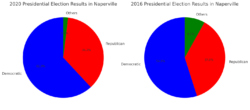
Naperville is represented by two U.S. Senators, three U.S. Representatives, four Illinois Senators and six Illinois Representatives.
U.S. Senators:
- Dick Durbin (D)
- Tammy Duckworth (D)
U.S. Representatives:
- Bill Foster, 11th District (D)
- Sean Casten, 6th District (D)
- Lauren Underwood, 14th District (D)
Illinois Senators:
- Laura Ellman, 21st District (D)
- John Curran, 41st District (R)
- Linda Holmes, 42nd District (D)
- Karina Villa, 25th District (D)
Illinois Representatives:
- Janet Yang Rohr, 41st District (D)
- Amy Grant, 42nd District (R)
- Barbara Hernandez, 83rd District (D)
- Maura Hirschauer, 49th District (D)
- Stephanie Kifowit, 84th District (D)
- Anne Stava-Murray, 81st District (D)
Education
Colleges & Universities
Naperville is home to several colleges and universities:
- North Central College: Located on a 59-acre campus in Downtown Naperville on Chicago Avenue, it was founded by a predecessor to the United Methodist Church in 1861 and has been in Naperville since 1870. It remains affiliated with the United Methodist Church and had 2,832 students enrolled in fall 2020.
- Northern Illinois University: Has a satellite campus on Diehl Road offering several courses.
- College of DuPage: Operates the Naperville Regional Center which offers various classes.
- DeVry University: Has its administrative headquarters and classrooms on Diehl Road in Naperville.
- Governors State University: Maintains a satellite campus on West 95th Street in Naperville.
- Indiana Tech: Has a satellite campus on North Aurora Road.
Primary & Secondary Schools in Naperville
Naperville is served by two public school districts, covering K-12 education, along with several private and parochial schools.
Naperville Community Unit School District 203
- Coverage: Central and northern Naperville, parts of Lisle and Bolingbrook.
- Oldest School: Ellsworth Elementary built in 1928.
- Newest School: Ann Reid Early Childhood Center opened in 2010.
Schools in District 203:
- High Schools: Naperville Central High School and Naperville North High School.
- Junior High Schools: Five within Naperville city limits.
- Elementary Schools: Fifteen within Naperville city limits, plus one junior high and one elementary school in Lisle.
Indian Prairie School District 204 (IPSD)
Formation: Created in 1972 from merged districts.
Schools in District 204:
- High Schools: Neuqua Valley High School, Metea Valley High School, Wheatland Academy and Waubonsie Valley High School.
- Junior High Schools: Seven.
- Elementary Schools: 21.
- Preschool: One.
Coverage: Western and southwestern Naperville, eastern Aurora, parts of Bolingbrook and Plainfield.
Private Schools
- All Saints Catholic Academy
- Bethany Lutheran School
- Calvary Christian School
- Covenant Classical School
- Naperville Christian Academy
- Raphael School
- Saints Peter and Paul School
Media
Television
Naperville has a community access TV station called Naperville Community Television (NCTV17). It airs community-based programming including news, sports, talk shows and coverage of local events. The station broadcasts on Channel 17 in Naperville and online at NCTV17.org.
Newspapers
- The Daily Herald: A daily newspaper serving suburban Chicago started in 1872 by Hosea Paddock.
- The Naperville Sun: A local newspaper serving Naperville published three days a week (Wednesday, Friday and Sunday). It was founded in 1935 and is now owned by the Chicago Tribune Media Group.
Radio
- 1610-AM WPFP 929: Broadcasts emergency, city and road information.
- WONC (89.1 FM): Owned and operated by North Central College, it broadcasts in an album-oriented rock format.
- WCKG (1530 AM): Broadcasts local news, talk shows and weather reports.
Infrastructure
Health Systems
Edward Hospital in Naperville, Illinois, was first established in 1907 as Edward Sanitarium and became Edward Hospital in 1955. In 2013, it merged with Elmhurst Hospital to create Edward-Elmhurst Health. Edward Hospital is a full-service facility with 352 private patient rooms. For many years Edward Hospital and others have tried to introduce a new hospital in Naperville but their requests have been turned down. As a result, Naperville remains the only large city in Illinois with just one hospital. To help reduce travel times for Naperville residents Edward Hospital tried to open a hospital in nearby Plainfield.
Duly Health and Care formerly known as DuPage Medical Group, has 16 locations in Naperville, offering a variety of medical services.
The University of Chicago Medical Center has two locations in Naperville providing pediatric and ENT (ear, nose and throat) services to the community.
Transportation
Roads
The Ronald Reagan Memorial Tollway (Interstate 88) passes through northern Naperville. US Route 34 (Ogden Avenue) enters the city from the west at Illinois Route 59. In 2015, a diverging diamond interchange, the first of its kind in Northeast Illinois was completed at the junction of Route 59 and Interstate 88.
Airport
The DuPage Airport (DPA), serving private and charter jets, is located 14 miles from downtown Naperville. Clow Airport in Bolingbrook is about 1.5 miles from Naperville’s southeastern border.
Naperville also has a private airport, the Naper Aero Club field (LL10), located on the western edge of town. This field is notable as the home of the Lima Lima Flight Team.
Train Service
Naperville’s first rail connection to Chicago was established in 1864 by the Chicago, Burlington and Quincy Railroad. Today, three tracks belonging to the BNSF Railway run through the north end of town. Passenger rail service is provided by Metra and Amtrak. Amtrak operates four daily trains through Naperville: the Illinois Zephyr and Carl Sandburg (both heading to Quincy, Illinois), the California Zephyr (heading to Emeryville, California) and the Southwest Chief (heading to Los Angeles). A third Metra station was planned on the Suburban Transit Access Route (STAR) at Wolf’s Crossing but the project has been inactive since 2012.
Bus Service
Pace provides rush hour bus service to the Metra stations. Previously, until 2008, they also offered local midday service. Both services have always been operated under contract, with First Student, a national transportation management firm, currently handling operations.
Pace directly operates several routes:
- Route 530: Connects Naperville to Aurora, serving Aurora’s Fox Valley Mall.
- Route 714: Connects Naperville to Wheaton, serving the College of DuPage.
Additionally, Pace runs Route 888, the “Tri-State Flyer,” a rush hour express service from Homewood and South Holland to corporate sites in the western suburbs, including northern Naperville.
Intercity bus services include routes from Chicago to Naperville and Davenport, Iowa, operated by Burlington Trailways and Greyhound Lines. Burlington Trailways buses stop at the Naperville Metra and Amtrak station on Fourth Avenue, while Greyhound Lines buses stop at the Route 59 Metra station.
Moving Service
Naperville is home to several moving and relocation companies that provide services for individuals and businesses. These companies offer a range of services including local and long-distance moving, packing and unpacking, storage solutions and specialized moving for delicate items.
Moving Companies in Naperville
- Two Men & a Truck: Provides local and long-distance moving services, packing and storage options.
- STI Movers: This well-known Naperville movers offers residential and commercial moving, packing services and storage solutions. They are known for their reliable service, professional staff, friendly and efficient moves.
- Jackson Moving & Storage: Provides residential and commercial moving services including international relocations. They also offer packing, unpacking and secure storage facilities.
- Hollander International Storage & Moving: Specializes in both local and international moves offering a wide range of services such as packing, storage and transportation of specialized items.
- Reebie Storage & Moving Co.: Offers full-service moving and storage solutions including residential, commercial and industrial moves.
These companies are equipped to handle all aspects of moving, ensuring a smooth and stress-free relocation experience for their clients.
Electricity
Naperville’s electric system is owned and run by the City of Naperville. The city gets its electricity from the Illinois Municipal Electric Agency a nonprofit government entity.
Follow Wordle Magazine to learn more about places like Naperville and others.
